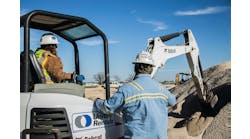The RER 100’s total rental revenue was $35,409.9 million, topping $30 billion for the first time. The 2023 RER 100’s total rental revenue for 2022 revenue was a 22.9-percent increase compared to 2021’s rental revenue of $28,813.7 million, the largest percentage year-over-year increase since the list jumped 25 percent in 2000 compared to 1999.
The top 10 of this year’s RER 100 was comparable, with the 10 largest posting $26,733.8 million, a 24.3-percent year-over year increase compared to the previous year’s total of $$21,505.7 million. For the top 10, it also was the largest increase since the year 2000.
The RER 100 listing covers North America-based rental companies and primarily covers rental revenue in North America. The two largest North American rental companies -- United Rentals and Sunbelt Rentals -- also posted large year-over-year rental volume increases. United Rentals became the first rental company to top $10 billion in rental revenue with $10.116 billion, a 23.3-percent year-over-year hike. Sunbelt also posted high-growth numbers, with $7.6 billion in rental revenue and a 26.7-percent rental volume increase.
Third place goes to Herc Rentals, which posted an even better 33.6-percent year-over-year increase. Rounding out the top 10 were Home Depot Rentals, H&E Equipment Rental Services (with a 31-percent rental volume jump), Maxim Crane Rental Corp., BrandSafway, EquipmentShare, Sunstate Equipment Co., and Aggreko North America.
Eleven companies from last year’s RER 100 were acquired, eight of which are not on this year’s RER 100, including perennial top 10 company Ahern Rentals. This year there are 11 new companies on the RER 100 ranging from No. 8 to No. 100.
Most RER 100 rental companies are reporting that their customers were for the most part plenty busy with a lot of construction activity. And construction will continue to be helped along by the Infrastructure Investment and Jobs Act and the Bipartisan Infrastructure Law, which provides $1.5 billion over the next five years to advance environmental justice, spur economic revitalization, and create jobs by cleaning up contaminated, polluted, or hazardous brownfield properties. Yes, there are concerns about the costs of fuel, and some inflation, but rental companies for the most part are strongly optimistic about their prospects going forward.
This is certainly not a blank check or a guaranteed ticket to paradise for everybody. As has been discussed in these and other pages in recent years, the difficulty in obtaining equipment has not been taken lightly. Part of the reason some companies sold was the cost of acquiring equipment made it difficult for them to keep their fleets replenished to the degree they needed. Some acquirers were partially motivated by the need for inventory as much as the quest for market share. Some rental companies passed up opportunities and projects because they lacked the fleet required.
Tom Showalter of Herc-U-Lift (No. 89), whose company grew its rental revenue 41 percent year over year, summed it up well. “It was a good year,” he said. “Could have been better if we could have gotten more equipment.”
Of course, not everybody who struggled with the issue of obtaining equipment grew that much. Despite the overall increase, some rental companies stayed relatively flat or only posted small increases. But the majority of the RER 100 companies were pleased with their results even though equipment was hard to obtain, qualified workers weren’t easy to find, and the costs of doing business definitely increased.
But whatever the external conditions, RER 100 companies also improve results because of their own preparations and increasingly more sophisticated systems. They don’t only do well because customers are calling. They also do better because levels of service get better every year.
To read the full 2023 RER 100, click here for the May 2023 digital edition of RER:






